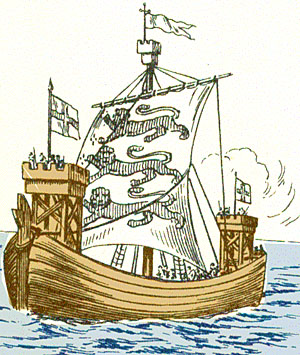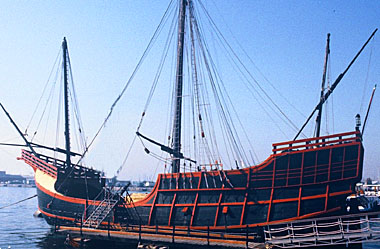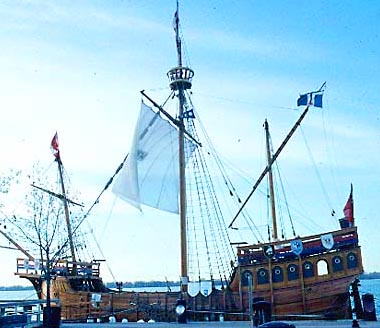
Artist's reconstruction of a medieval warship, its
sail sporting the heraldic symbol of the Plantagenets. Fore and aft
castles are here depicted as raised so high that they would have risked
destabilizing the ship.
There were a number of common ship types in medieval Europe. Ship designs produced by different cultures were influenced by such things as intended uses (e.g human transport, short-distance trade, long-distance freighting, combat), the depth and roughness of waters to be traversed, character of local coasts and harbourage, kinds of wood available, traditional techologies and design solutions, and a general trend towards building ships that were larger, yet better able to cope with the stresses of oceanic sailing. In broad terms a distinction has been made between ship types developed in northern Europe and those constructed by Mediterranean countries. But as merchants from all over Europe sought commercial opportunities further afield, knowledge of different design solutions spread and there was cross-fertilization between the various ship types.
The seafaring peoples we know as the Vikings used the long ship to carry human cargoes on raids and migrational journeys, and the knarr for trading ventures aalong Scandinavian coasts and to Iceland/Greenland. The long ship, a large, open, galley-style vessel suitable for beaching and easy re-launching, remained a viable model and, with the addition of fighting platforms at either end, served in warfare into the thirteenth century. However, although the knarr continued to be a model produced into the same period (the name buss being applied to some of the later variants), it was better suited to the deep Scandinavian waters and harbourages, and proved less useful as long-distance commerce revived and urban merchants wished to transport larger and heavier cargoes (e.g. grain, construction materials) into waters that were often relatively shallow.
Another type of ship, the cog, derived from a barge-style fat-bottomed boat, developed in response to the need for merchant vessels able to transport bulkier loads. It was employed effectively by the towns of the Hanseatic League in particular, as they captured a prominent role in international trade (particularly the cloth-making industry focused in the Low Countries, whose waters were shallow). Wide and spacious, it proved a good workhorse, and built sturdily enough to be beachable so that it could land its cargo (or withstand accidental grounding) at a wide range of locations along the tidal coasts of northern Europe. Their hulls were more rounded than those of long ships or other galleys. Although slower and less manoeuvrable than the long ship, the cog became the dominant model in northern Europe from the thirteenth and fourteenth centuries. It relied primarily on its single square sail, although some of the earlier and smaller versions at least could be rowed short distances – useful when entering or leaving harbour, or navigating close to shore. This model too could be fitted out with castles for self-defence or offensive uses.
A separate and probably more ancient line of development produced the hulk, or holk, another barge-style vessel, although it did not have widespread use until the fourteenth century. There are fewer medieval depictions of hulks, but they feature a pivoting side rudder (enabling them to beach on foreshores), sail, and oars. By the close of the fourteenth century, the best features of knarr, cog, and hulk had been merged into a more generic form of merchantman, with a flat plank bottom, driven by a single, square, billowing sail (occasionally supplemented by a second mast and sail) and steered by a rudder at the stern (necessitating anchoring off a wharf or in a fairway), but without oars. Cogs were slower and less manoeuvrable than oared vessels, but their shape and possible use of the mast as a derrick made them more servicable as merchantmen carrying bulky cargoes and as supply ships supporting military expeditions.
Meanwhile the Christian countries surrounding the Mediterranean had stuck with the Roman galley style of ship, propelled by oar but usually assisted by the triangular lateen sail which had long been used by Arab craft; large galleys incorporated additional masts (an idea later adopted by northern ship-builders). Like northern vessels, they were fitted out with castles. The Mediterranean galley of the Late Middle Ages is particularly associated with Venice, as the leading sea-power in that part of the world, and fitted Venetian needs well, in terms of speed and emphasis on light cargoes of luxury (rather than bulk) goods. As Mediterranean sailors and ship-builders came more in contact with northern European ships, as a result of expanding trade and the Crusades, the square sail started to be adopted for southern galleys; as this caught on, sail may have become the primary method of propulsion. The reinforced hull of the cog, however, was considered a detriment to manoeuvrability and unnecessary in the non-tidal Mediterranean.
Merging the best features of southern and northern ship types continued in the fifteenth century. Northern builders had realized, towards the close of the previous century, that steering and wind propulsion were improved by an additional mast above the aftcastle, carrying a lateen sail; this second mast became a common feature of new ships during the fifteenth century, and some ships were fitted with a third mast and sail, above the forecastle.
As the result of the convergence, the predominant type of ship by the late fifteenth century was the carrack. In addition to the changes indicated above, a distinctive feature was that fore and aft castles were designed as integral parts of the hull. Rigging became more elaborate; for instance, the foresail and foremast were steadied with the help of ropes attached to a bowsprit projecting from the forecastle; the bowsprit might support a yard-arm bearing a small sail. Hull modifications were also made to support heavier artillery.
The height of the new design of the carrack castles gave them a combat advantage over older ship types, in terms of firing down on the enemy and in grappling and boarding (and protection from being boarded). It also facilitated the use of spaces beneath the castles for crew quarters. But the new castles took a form too bulky for efficient sailing, the carrack being prone to rolling and even toppling: the fate of Henry VIII's Mary Rose, an example of the trend towards building larger carracks as warships.
The Genovese, as allies of the French, had used carracks against the English during the reign of Henry V, prompting him to invest in new dockyards at Southampton and the construction there of a squadron of warships, including the largest yet built in England, the three-masted Gracedieu, representing the last hurrah of the cog. The carrack would be superseded in the sixteenth century by the galleon, which was to dominate maritime voyages and naval operations for the next several centuries.

A modern, conjectural reconstruction of Columbus' ship
the Santa Maria (1492), at a Barcelona harbour in 1989. Although the
Santa Maria is believed to have been a small three-masted carrack,
around 80 feet long, this reconstruction is modelled after the caravels that
Columbus used for the rest of his small fleet; Columbus used both names
to describe his flagship.
Photo © S. Alsford
The caravel was another type of ship that developed during the fifteenth century, appearing first in the Mediterranean and perhaps originally used for fishing, but later employed for transoceanic exploration. Seeking better manoeuvrability and speed, and prepared to sacrifice carrying capacity (rigging having improved to the point where smaller crews sufficed to handle it) the caravel was built lighter and sleeker than the carrack, avoiding the ;atter's high castles which, together with the heavy artillery placed atop them, had made for instability in rough weather. Early caravel types may in fact only have had a castle at the stern, although forecastles were subsequently reintroduced. Initially it used the lateen sail, but was subsequently adapted to the square sail (caravela redonda).

Another modern (and again conjectural) reconstruction,
this time credibly representing Cabot's Matthew (1497) as a caravel.
Here seen in Toronto harbour in 1991, but normally docked at Bristol.
The ship is some 64 feet in length. The design illustrates the transition
from a traditional castle that was fitted atop the hull – the
Matthew's forecastle being a late variant of that style –
to one built into the hull structure (the aftcastle).
Photo © S. Alsford